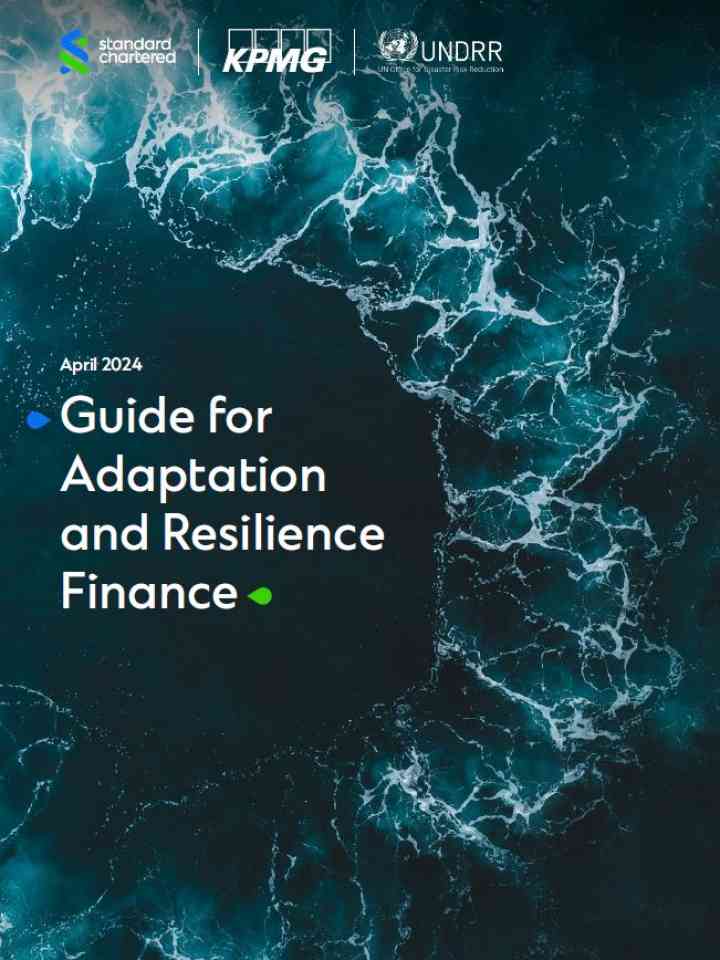Launch of a new roadmap for financing adaptation and resilience

- Call for step-change in financing adaptation and resilience as breakthrough Guide for Adaptation and Resilience Finance (the Guide) offers clarity and transparency to accelerate investment.
- The Guide sets out – for the first time – eligible financeable activities and guidance on what constitutes adaptation and resilience investment, alongside a practical roadmap for financing and investment opportunities.
- Created by Standard Chartered, KPMG and the United Nations Office for Disaster Risk Reduction (UNDRR) – with support from 20+ leading financial institutions, multilateral development banks (MDBs) and NGOs – the Guide responds to the urgent call to mobilise private finance for adaptation and resilience, issued at COP28.
The United Nations Office for Disaster Risk Reduction (UNDRR), Standard Chartered, and KPMG are today calling for a step-change in the mobilisation of finance for adaptation and resilience ahead of COP29, particularly in emerging markets. This comes as Standard Chartered, KPMG and UNDRR launch a breakthrough roadmap to galvanise and align sector-wide efforts to address the significant finance shortfall in adaptation and resilience.

The Guide for Adaptation and Resilience Finance, developed with support from more than twenty leading financial institutions, Multilateral Development Banks (MDBs) and NGOs – including the African Development Bank and the United Nations Environment Programme Finance Initiative – represents a practical tool for investors, commercial banks, and other financial institutions by:
- Setting out a common reference for adaptation and resilience alongside a list of financeable adaptation and resilience themes and activities, forming a classification framework
- Simplifying the decision-making process when financing adaptation and resilience through principles and guidance based on latest best practice definitions and frameworks. This Guide aligns with the seven resilience themes outlined in the UNDRR and Climate Bonds Initiative Climate Resilience Classification Framework.
- Identifying priority investments and their co-benefits, including emissions reductions and nature protection and conservation, alongside adaptation and resilience benefits
The Guide maps over 100 investable activities across adaptation and resilience, including: climate-resilient crops, vertical farming, natural flood protection, water conservation and efficiency measures, public hospital infrastructure investment, renewable energy storage solutions, and mangrove conservation and replanting.
The latest UN analysis on global climate impacts underlines the need for urgent action, with 2023 marking the hottest year on record amid rising sea levels and the increased frequency and intensity of extreme weather. Economic losses from natural and climate-related disasters are estimated to cost more than USD 330 billion per year, and this figure is just the tip of the iceberg of the real uncounted costs on people’s lives.
Today, less than 10% of all climate finance is allocated to adaptation. The global adaptation financing gap is widening, and current levels of funding remain well below the estimated USD 212 billion per year needed through to 2030 in developing countries alone.
Research conducted by Standard Chartered, published in the Bank’s Adaptation Economy Report, found that for every USD 1 spent on adaptation this decade, an economic benefit of USD 12 could be generated – highlighting the significant economic pay-off of early action towards adaptation and the potential gains for investors.
Paola Albrito, Acting Special Representative of the UN Secretary-General for Disaster Risk Reduction United Nations Office for Disaster Risk Reduction (UNDRR), said: “This guidance comes at an important moment as governments look to enable greater investment in resilience, including through the G20 work on disaster risk reduction. Financial actors can get ahead and take advantage of this guidance to develop financial products, such as adaption and resilience loans and bonds, that can mobilise private capital. I encourage the financial community to use this opportunity to set targets for themselves in terms of investment portfolios allocated to these objectives.”
Marisa Drew, Chief Sustainability Officer, Standard Chartered, said: “Finance and investment for adaptation and resilience needs to rapidly scale to address a critical shortfall amid rising demand. We need to embed adaptation and resilience into financial decision-making, to ensure we understand and manage the financial risks and recognise the potential of adaptation and resilience as investable asset classes. The Guide will help offer confidence to investors looking to allocate capital to adaptation and resilience projects, helping to advance sector-wide understanding and drive the critical step-change we need to see in capital mobilisation for this crucial area of sustainable finance.”
David Greenall, Global Managing Director, Climate Risk, Decarbonisation, Nature & Adaptation, KPMG International, said: “Emerging markets and developing economies have a disproportionate risk of exposure to the negative effects of rising temperatures and extreme weather, and in many cases have fewer resources or less capacity to respond. We need capital to move in the right direction and to mainstream natural and climate hazard resilience into financial flows. Commercial banks and private investors have an opportunity to lead in meeting the adaptation challenge. I encourage the banking and investment community to use this Guide as a key resource when considering how and where to invest more proactively and ambitiously in a resilient future.”
The Guide responds to a COP28 call for consistent and common language to align efforts in addressing the shortfall – outlined in the UAE Framework for Global Climate Resilience, as part of the UAE Consensus agreed at last year’s UN climate summit.
Ahead of COP29, the private sector, MDBs and other financial institutions have a vital role to play, in collaboration with governments and wider stakeholders, to accelerate the deployment of capital towards adaptation and resilience. To galvanise efforts ahead of the summit, Standard Chartered, KPMG and UNDRR are inviting further collaboration with plans for financial sector dialogues, including a convening at Ecosperity Week in Singapore (17 April).
For further information and interviews, please contact the UNDRR media team